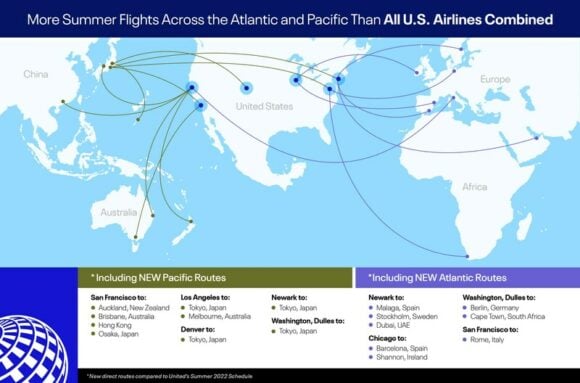
323427770 687661986137310 8985092622802475292 n
UPDATE – United Airlines reported a $-194 million Q1 loss for what has been a strong first quarter. The carrier generated an all-time high operating free cash flow of $3.0 billion, which according to CEO Scott Kirby will help United achieve its cost targets for the full year. United released its results late on April 18. United “extremely proud” with Q1 performance.
The first quarter produced total revenues of $11.429 billion, up from $7.566 billion in 2022. Passenger revenues were up by 61.8 percent to $10.274 billion from $6.348 billion. Total revenues per available seat mile (TRASM) improved by 22.5 percent year on year to $17.39 cents.
The US domestic market generated $6.485 billion in passenger revenues, up 43.8 percent over 2022. Next best was Europe at $1.260 billion, up 129.1 percent, ahead of Latin America at $1.213 billion (+51.6 percent) and the Pacific at $962 million (+323.8 percent). The Middle East and Africa contributed $354 million (+35.6 percent) to pax revenues, something that will likely change once the extensive partnership with Emirates has come fully alive.
Other operating revenues generated $757 million versus $591 million, while cargo revenues were 36.5 percent down year on year to $398 million. United’s operating expenses grew by 28.3 percent to $11.472 billion, with fuel costs one of the contributors ($3.174 billion) but salaries, aircraft maintenance, distribution costs, and other operating expenses also up. Costs per available seat mile (CASM) including fuel were up by four percent to $17.46 cents. Excluding fuel, CASM was actually 0.1 percent lower.
Consequently, Q1 ended with a tiny $-43 million operating loss (2022: $-1.376 billion), a pre-tax loss of $-256 million ($-1.752 billion) in line with United’s March guidance, and a net loss of $-194 million ($-1.377 billion), a result that made Kirby “extremely proud.” The airline ended the quarter with $7.6 billion in cash and cash equivalents and $38.6 billion in net debt, down $4.6 billion from March 2022. For the record: United ended 2022 with a $737 million net profit.
United is most happy with its operational performance in the winter quarter. Despite setbacks from winter weather, its seat cancel rate at 1.09 percent was the lowest since Q1 2012. In on-time performance, the airline was number 1 in Chicago, Denver, Houston (George Bush), and Los Angeles.
Travel patterns have changed
Looking ahead, United shares the same cautious optimism as its rival Delta Air Lines for the upcoming months. “We are watching the macroeconomic risks carefully, but demand remains strong, especially internationally, where we are growing at twice the domestic rate. We expect all of these factors will keep us on track to achieve our full-year adjusted diluted EPS target,” Scott Kirby says in the earnings release. United said on April 6 that it will grow its northern summer schedule by 25 percent to include 114 destinations in Europe, the Middle East, and the Asia Pacific. This includes seasonal services. There will be 207 daily transatlantic flights this summer. International available seat miles (ASM) will be 46 percent this summer versus 43 percent in 2019.
During Wednesday’s earnings call, United noted that the operating environment is more challenging. Travel patterns have changed, with a noticeable peak seasonality between March and October and weaker business demand in January and February and before in the first half of November and December. The recent bank scare after the Silicon Valley Bank troubles caused domestic business travel to drop briefly, but bookings for the coming months are recovering.
Now that international travel has fully re-opened since last year, US travelers are looking abroad again which explains why international is growing at twice the rate. This makes it unlikely that domestic travel in Q2 will be as strong as it was last year when more travel restrictions were in place, yet domestic revenues should still be well up year over year. Q2 revenues are expected to be up fourteen to seventeen percent over last year, of which almost thirty percent will come from international and some eight percent from domestic. Capacity will be up around 18.5 percent year on year. All international widebodies will have the Polaris premium cabin.
Looking at Q1 and Q2, Kirby said: “We believe demand is structurally different from pre-pandemic and are still figuring out that new normal,” said Kirby. For instance, remote work schedules since the pandemic are there to stay and are having an impact. He repeated what he said in January: “You can’t run your airline like it is 2019.” This will also affect United’s regional business. With the pilot shortages it has had, regional capacity has seen some significant capacity reductions. The days when United operated 600 regional jets are over. Although the pilot situation has stabilized recently, the future is upgauging by replacing regional jets with mainline Boeing MAX over the next few years as was outlined in the 2021 United Next strategy.
Australia and New Zealand expansion
The airline announced on Tuesday that it will significantly expand its network to Australia and New Zealand from October to December, adding forty percent more flights to the schedule. On December 1, it will launch the first direct service between San Francisco and Christchurch. In October and November, new flights are added between Los Angeles and Brisbane, and Auckland as well as from San Francisco to Brisbane, Sydney, and Melbourne. At Brisbane, United will connect to the network of Virgin Australia.
As the carrier points out, “United already flies to more destinations in Australia and New Zealand than all other US carriers combined, and now will have more flights and serve more destinations in the region from the US than any other carrier in the world.” Let’s see what the response from Qantas and Air New Zealand will be.
Views: 2





“Total revenues per available seat mile (TRASM) improved by 22.5 percent year on year to $17.39”
I wonder is this 17.39 cents instead of USD?
If the flight distance is 1,000 miles, so the revenue per passenger is 1,000 x $17.39 = $17,390?
Yes, this is $17.39 cents. I updated the text.